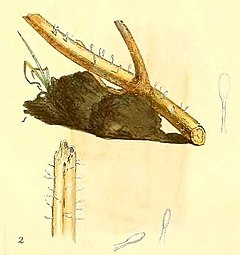Typhula
| Typhula | |
|---|---|

| |
| Typhula quisquiliaris, as illustrated by James Sowerby | |
| Scientific classification | |
| Kingdom: | Fungi |
| Division: | Basidiomycota |
| Class: | Agaricomycetes |
| Order: | Agaricales |
| Family: | Typhulaceae |
| Genus: | Typhula (Pers.) Fr. |
| Type species | |
| Typhula phacorrhiza () Fr.
| |
| Species | |
| |
| Synonyms | |
|
Cnazonaria Corda | |
Typhula is a genus of clavarioid fungi in the order Agaricales. Species of Typhula are saprotrophic, mostly decomposing leaves, twigs, and herbaceous material. Basidiocarps (fruit bodies) are club-shaped or narrowly cylindrical and are simple (not branched), often arising from sclerotia. The anamorphic genus Sclerotium is (in its modern sense) a synonym of Typhula. A few species are facultative plant pathogens, causing a number of commercially important crop and turfgrass diseases.
Taxonomy[]
The genus was first introduced as a section of Clavaria by South African-born mycologist Christiaan Hendrik Persoon in 1801. He differentiated Typhula from Clavaria on the basis of fruitbody shape (Typhula having a distinct head and stem). The name was taken up at generic level by Elias Magnus Fries in 1818. Fries described four species in the genus, including the type species Typhula phacorrhiza. Subsequent authors described another 150 or so species in Typhula.[1]
The genus was revised in 1950 by E. J. H. Corner, who characterized Typhula species as having fruit bodies arising from sclerotia, the genera Pistillaria and Pistillina accommodating similar species lacking sclerotia.[2] A later and more specialist revision by Jacques Berthier (1976) placed both these latter genera in synonymy.[3] No later taxonomic studies have been published, though DNA sequences of the type species have indicated the placement of Typhula within the Agaricales.[4]
The genus Sclerotium[]
Sclerotium was introduced by the German mycologist and theologian in 1790 to accommodate fungal sclerotia (propagules composed of thick-walled hyphae). Over 400 species were subsequently added to this form genus, comprising sclerotia or sclerotia-like entities from a wide range of fungi within the phyla Ascomycota and Basidiomycota.
With a move towards a more natural classification of fungi, the genus Sclerotium is now restricted to sclerotial anamorphs of Typhula, since the type species, Sclerotium complanatum, is the anamorph of . Other species have been transferred elsewhere.[5] Even in its restricted sense, the genus is superfluous since there is no good reason why hyphal propagules should have a separate scientific name from the fungi of which they are part.
Description[]
Basidiocarps (fruit bodies) arise singly or severally from a sclerotium or directly from the substrate. Fruit bodies are filiform (hair-like) to club-shaped, typically with a distinct sterile stalk and fertile head, normally white, in some species buff to pink, or with a dark reddish stem. The sclerotia (when present) are spherical to lentil-shaped, hard and horny, yellow-brown to blackish brown. Microscopically, the hyphal system is monomitic, the hyphae with or without clamp connections. The basidia produce 2 to 4 basidiospores that are smooth (lobed in one species), colourless, and amyloid or inamyloid.[3]
Habitat and distribution[]
Typhula species mostly occur as saprotrophs on dead herbaceous stems, fern stems, grass stems, fallen leaves, and woody detritus. Some species occur on a wide range of host plants, others—such as Typhula quisquiliaris on bracken—appear to be host-specific.[3] A few species are or can become facultative (opportunistic) parasites of crops and turfgrass.
Most species have been described from the north temperate zone, but little research has been undertaken in the tropics or southern hemisphere, where they are either less common or (as yet) overlooked.[3]
Economic importance[]
The psychrophilic species Typhula ishikariensis and Typhula incarnata are the causal agents of (also called speckled snow mould or typhula blight), a disease that can destroy turfgrass when covered for a long period with snow. It is a particular problem on golf courses established in unsuitable areas.[6] More importantly, the same two species can also damage crops of winter wheat, as can .[7]
References[]
- ^ "Index Fungorum - Search Page".
- ^ Corner EJH. (1950). A monograph of Clavariaand allied genera. Cambridge University Press.
- ^ a b c d Berthier J. (1976). Monographie des Typhula, Pistillaria et genres voisins. Société Linnéenne de Lyon.
- ^ Matheny PB, et al. (2006). "Major clades of Agaricales: a multilocus phylogenetic overview". Mycologia. 98 (6): 982–995. doi:10.3852/mycologia.98.6.982. PMID 17486974. http://www.mycologia.org/cgi/content/full/98/6/982
- ^ Xu Z, Harrington TC, Gleason ML, Batzer JC (2010). "Phylogenetic placement of plant pathogenic Sclerotium species among teleomorph genera". Mycologia. 102 (2): 337–346. doi:10.3852/08-189. PMID 20361501. S2CID 33608842. http://www.public.iastate.edu/~tcharrin/Sclerotium.pdf
- ^ "Archived copy". Archived from the original on 2013-04-10. Retrieved 2013-02-21.CS1 maint: archived copy as title (link)
- ^ Schneider EF, Seaman WL (1986). "Typhula phacorrhiza on winter wheat". Canadian Journal of Plant Pathology. 8 (3): 269–276. doi:10.1080/07060668609501799.
External links[]
- "Typhula (Pers.) Fr". Atlas of Living Australia.
- Typhulaceae
- Agaricales genera